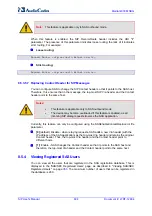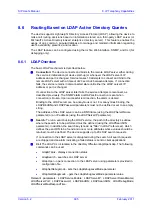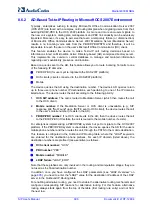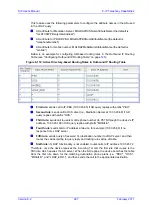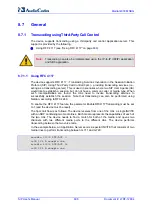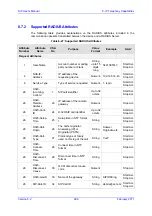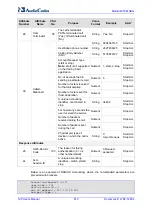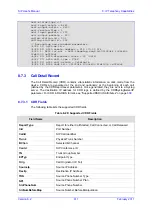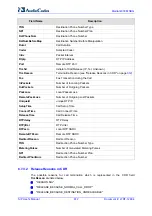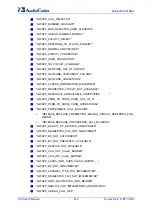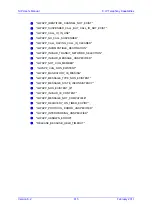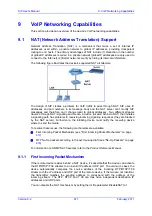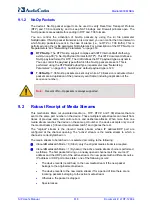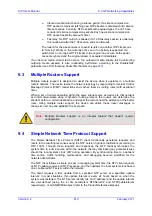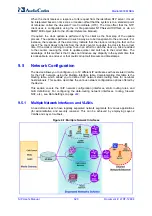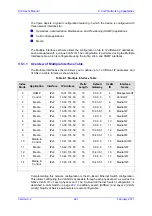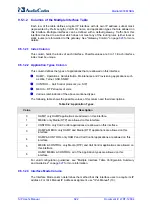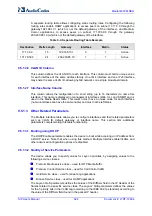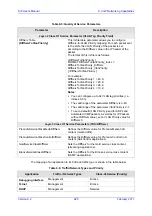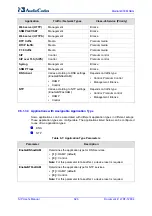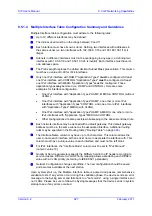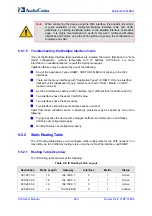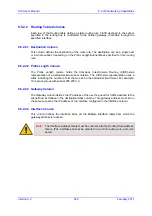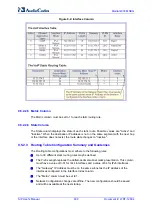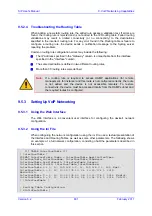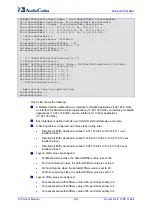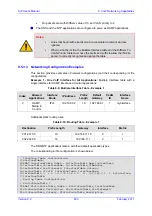
SIP User's Manual
618
Document #: LTRT-12804
Mediant 800 MSBG
9.1.2
No-Op Packets
The device's No-Op packet support can be used to verify Real-Time Transport Protocol
(RTP) and T.38 connectivity, and to keep NAT bindings and Firewall pinholes open. The
No-Op packets are available for sending in RTP and T.38 formats.
You can control the activation of No-Op packets by using the
ini
file parameter
NoOpEnable. If No-Op packet transmission is activated, you can control the time interval in
which No-Op packets are sent in the case of silence (i.e., no RTP or T.38 traffic). This is
performed using the
ini
file parameter NoOpInterval. For a description of the RTP No-Op
ini
file parameters, see ''Networking Parameters'' on page
.
RTP No-Op:
The RTP No-Op support complies with IETF Internet-Draft draft-wing-
avt-rtp-noop-03 ("A No-Op Payload Format for RTP"). This IETF document defines a
No-Op payload format for RTP. The draft defines the RTP payload type as dynamic.
You can control the payload type with which the No-Op packets are sent. This is
performed using the RTPNoOpPayloadType
ini
parameter (see ''Networking
Parameters'' on page
). AudioCodes’ default payload type is 120.
T.38 No-Op:
T.38 No-Op packets are sent only while a T.38 session is activated. Sent
packets are a duplication of the previously sent frame (including duplication of the
sequence number).
Note:
Receipt of No-Op packets is always supported.
9.2
Robust Receipt of Media Streams
This mechanism filters out unwanted media (i.e., RTP, RTCP, and T.38) streams that are
sent to the same port number on the device. These multiple media streams can result from
traces of previous calls, call control errors, and deliberate attacks. When more than one
media stream reaches the device on the same port number, the device accepts only one of
the media streams (“inbound media stream latch”) and ignores the rest.
The "original" stream is the inbound media stream whose IP address/UDP port are
configured at the channel opening. The "active" stream is the media stream to which a
channel is currently latched on.
The media stream to be latched on is selected according to the following:
InboundMediaLatchMode = 0 (Strict): only the original media stream is accepted.
InboundMediaLatchMode = 1 (Dynamic): the active media stream choice is performed
as follows. The first packet arriving on a newly opened channel sets the source IP
address and the UDP port of the active stream. If a new packet with a different source
IP address or UDP port arrives later, one of the following occurs:
•
The device reverts (re-latches) to the new media stream if the new packet
belongs to the original media stream.
•
The device reverts to the new media stream if for a period of time there are no
incoming packets belonging to the active media stream.
•
Otherwise, the packet is dropped.
•
Special cases:
Summary of Contents for Mediant 800 MSBG
Page 2: ......
Page 366: ...SIP User s Manual 366 Document LTRT 12804 Mediant 800 MSBG Reader s Notes ...
Page 372: ...SIP User s Manual 372 Document LTRT 12804 Mediant 800 MSBG Reader s Notes ...
Page 390: ...SIP User s Manual 390 Document LTRT 12804 Mediant 800 MSBG Reader s Notes ...
Page 404: ...SIP User s Manual 404 Document LTRT 12804 Mediant 800 MSBG Reader s Notes ...
Page 616: ...SIP User s Manual 616 Document LTRT 12804 Mediant 800 MSBG Reader s Notes ...
Page 636: ...SIP User s Manual 636 Document LTRT 12804 Mediant 800 MSBG Reader s Notes ...
Page 652: ...SIP User s Manual 652 Document LTRT 12804 Mediant 800 MSBG Reader s Notes ...
Page 886: ...SIP User s Manual 886 Document LTRT 12804 Mediant 800 MSBG Reader s Notes ...

